Single sign-on with Google Workspace
Learn how to setup single sign-on in the Dashboard with Google Workspace.
Stripe supports Single Sign-On (SSO), allowing you to manage your team’s access and roles through your identity provider (IdP). This means your team can access Stripe without needing separate passwords. When SSO is configured, users (team members) are automatically redirected to your IdP for authentication when they sign in to Stripe.
Your IdP verifies if they have a valid role assignment to your Stripe accounts or organization, and generates a SAML assertion used by Stripe to assign the proper roles in the Stripe Dashboard. When your account requires SSO, you must update team roles through your Identity Provider (IdP) for security. Changes to a team member’s roles only appear in Stripe after they sign in to the Dashboard again using the updated SAML assertion.
Set up SSO
To integrate your Stripe account with your IdP, you’ll need to complete three steps:
- Prove ownership of the domains that your team will use to sign in to the Dashboard.
- Configure Google Workspace to work with Stripe.
- Configure Stripe to work with Google Workspace.
Proving Domain Ownership
A domain is the portion of an email address after the @ symbol (such as kavholm.). You must configure SSO for Stripe for each of your business’s email domains. To verify domain ownership:
- Go to Single sign-on (SSO) in the Stripe Dashboard, and click + New domain to view your account’s unique verification code.
stripe-verification=4242424242424242424242 - Add the verification code as a
TXTrecord to your Domain Name System (DNS) provider. - Return to the Stripe Dashboard, and click Save and verify. Depending on your DNS provider, it can take 24 hours or more to verify your domain.
- After successful verification, don’t delete the
TXTrecord from your DNS provider. If you delete it, you might lose access to the Dashboard because Stripe frequently checks the DNS records of your domain.
Multiple Stripe accounts support
If you’re configuring SSO for multiple Stripe accounts, you must create an organization to centrally configure SSO across all of your accounts. Alternatively, contact Stripe support to verify your domain across separate accounts with one shared verification code.
Configuring Google Workspace
Cuidado
These instructions require changes in the Google Workspace Admin console.
- To configure Google Workspace, create a new SAML application to represent the relationship between Google Workspace and the Stripe Dashboard. In the menu accessible at the top left, select Apps, and click Web and mobile apps.
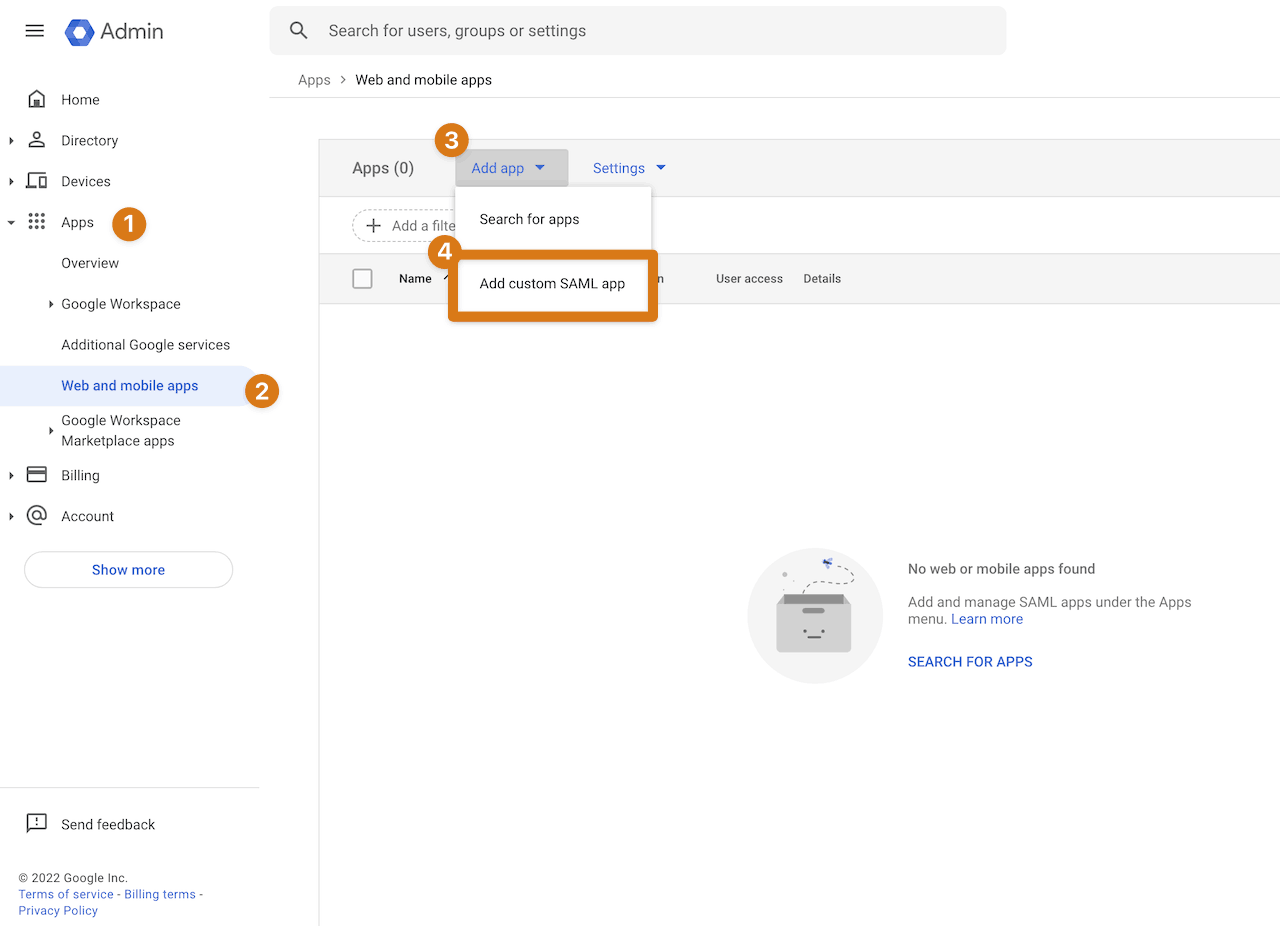
- Click the Add app menu and select Add custom SAML app. On the App details screen, set the App name and any other parameters you need. Click Continue.
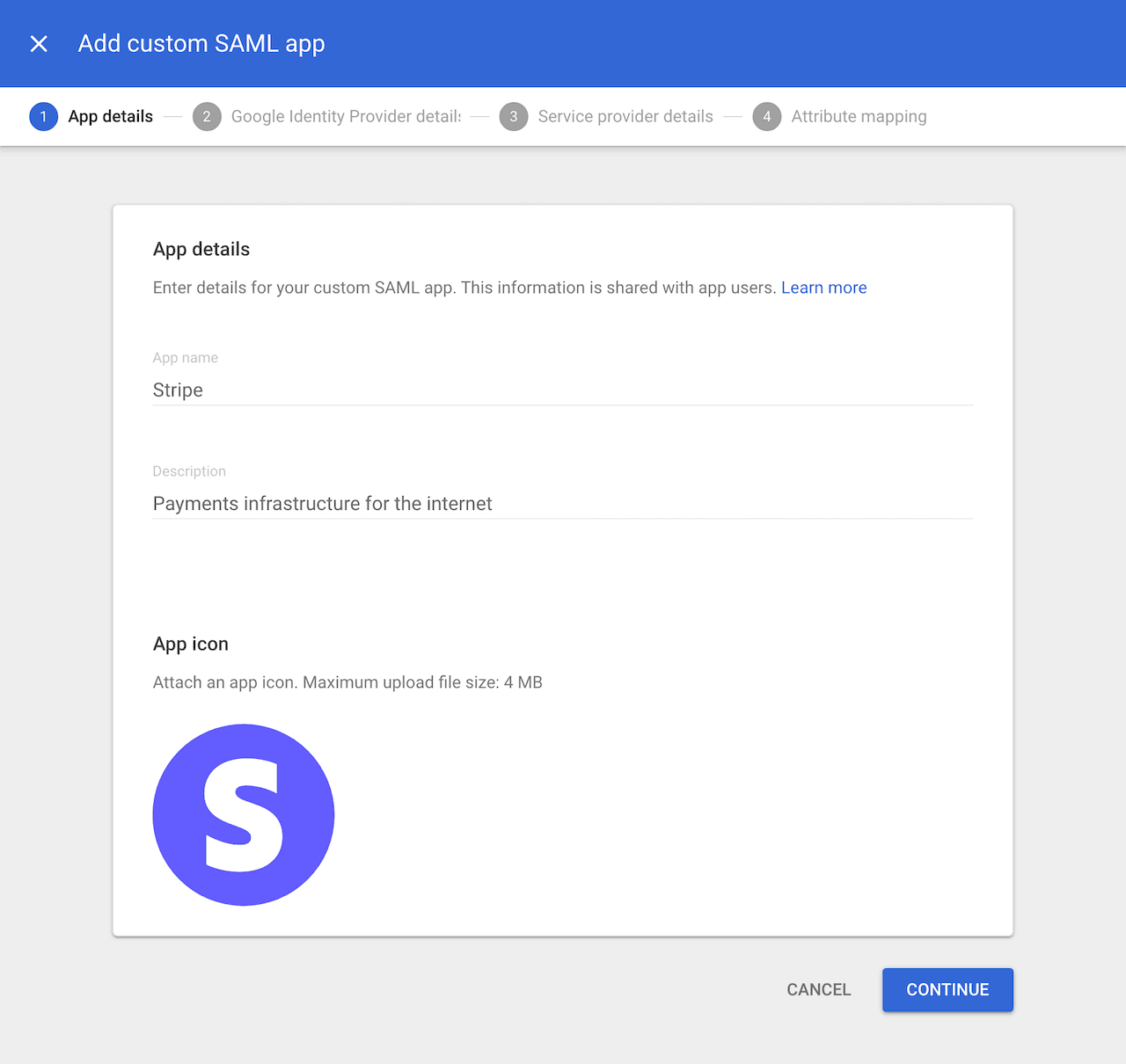
- Save the SSO URL, Entity ID, and download the certificate. You need these in step 3. Next, click Continue.
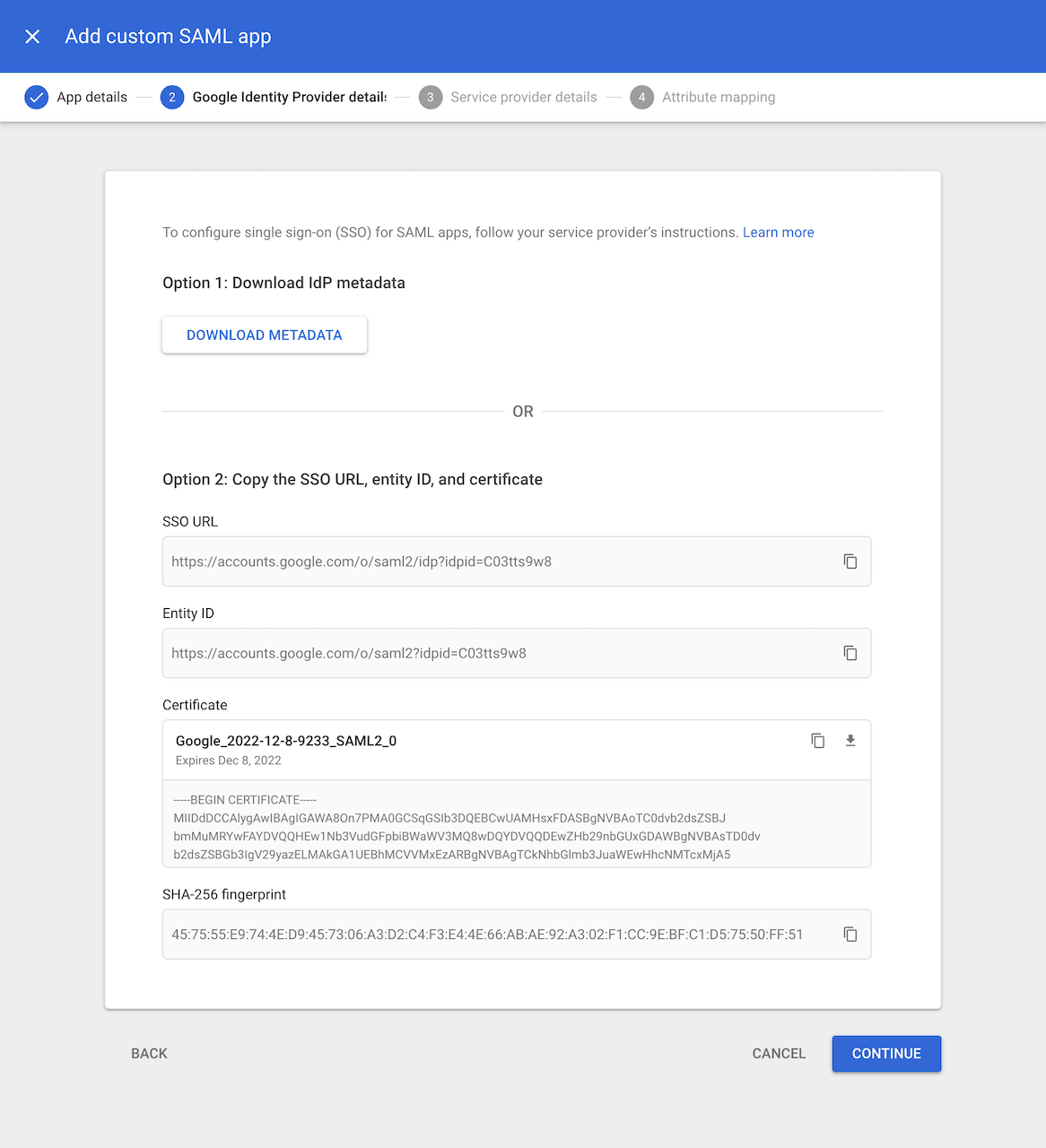
On the Service Provider Details screen, configure the following:
Setting Value ACS URL https://dashboard.stripe. com/login/saml/consume Entity ID https://dashboard.stripe. com/saml/metadata Name ID Basic InformationandPrimary EmailName ID Format EMAIL
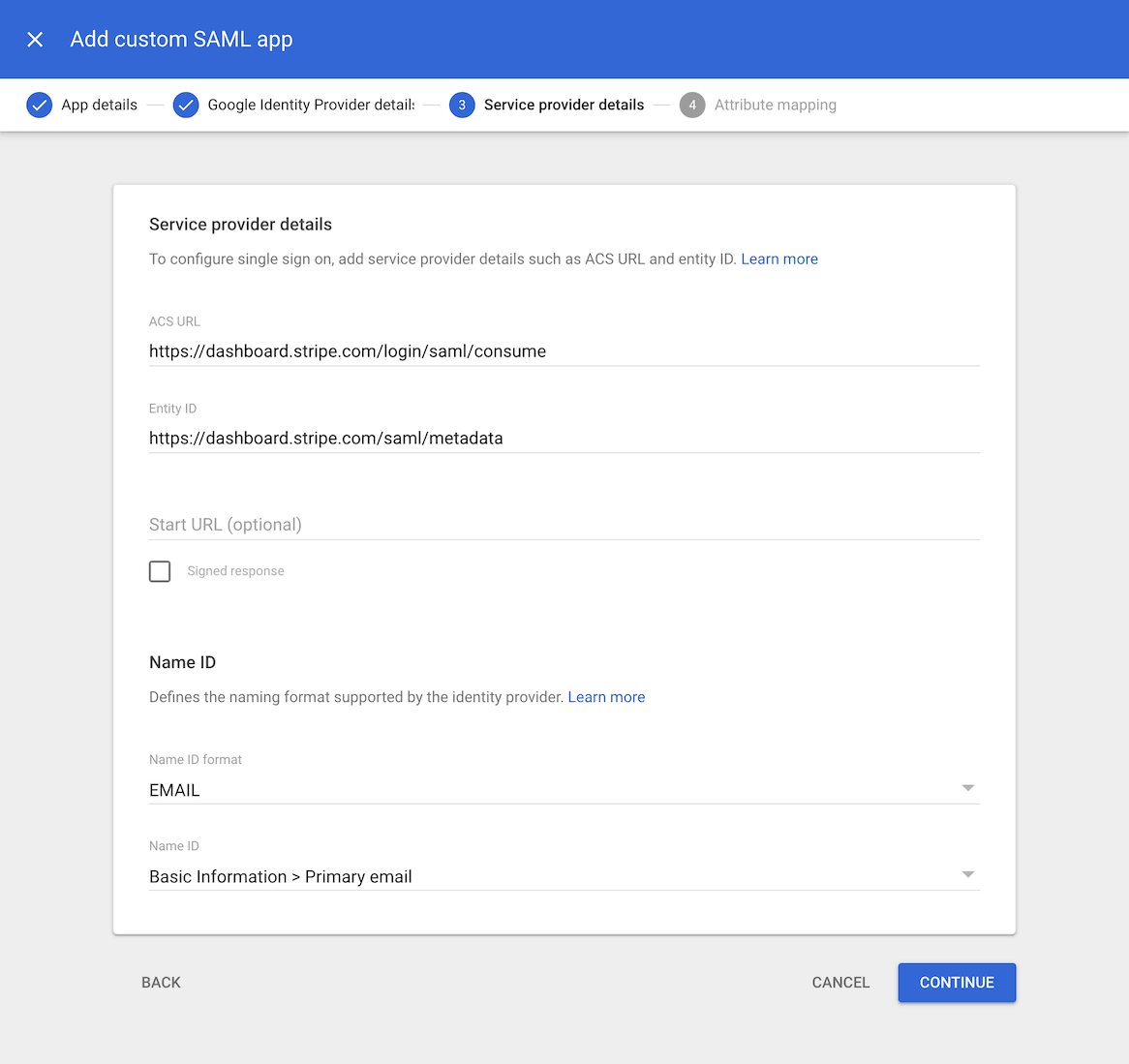
- Click Continue and then click Finish on next screen to complete the SAML application set up.
Create a Google Workspace custom user attribute
To authenticate a team member to Stripe, configure Google Workspace with the role they have in the Stripe Dashboard per Stripe account. To do this, create an Attribute Mapping from a Google Workspace user property to your SAML application, then create a custom user property in Google Workspace to store this information.
- In the admin console main menu at the top left, select Directory, and click Users.
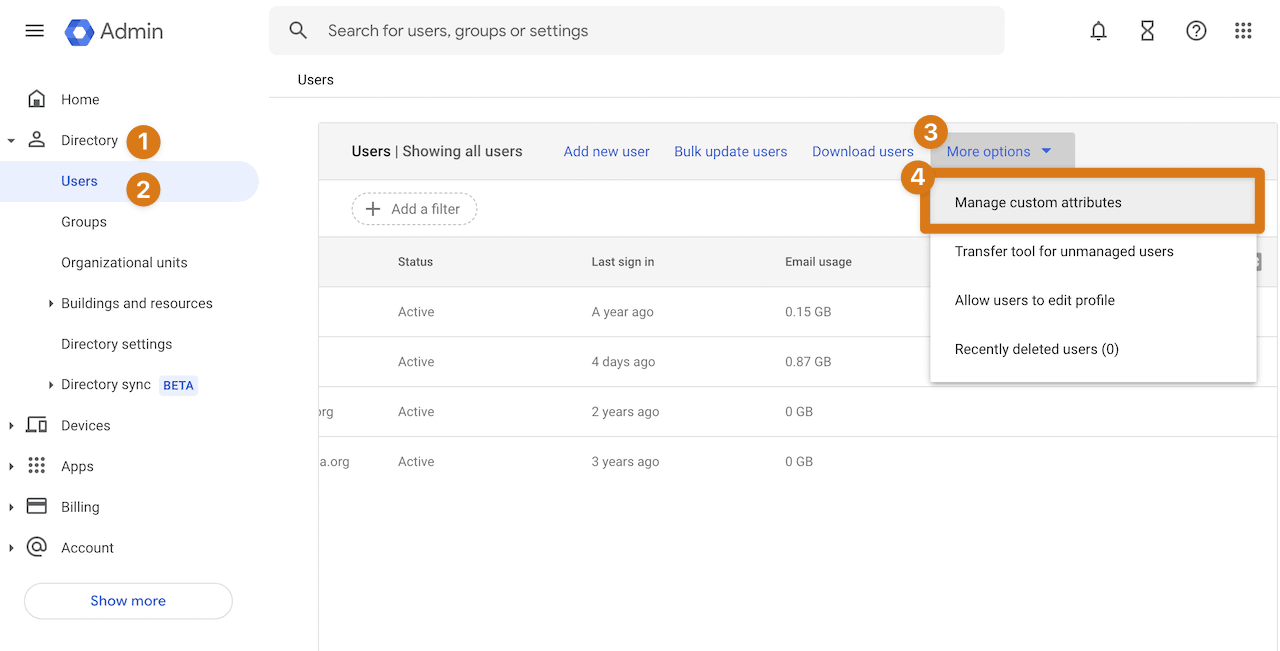
- In the menu of the user list, click More options and select the Manage custom attributes item. In the top right, click Add custom attribute.

- Enter a Category, Description, and Name as needed. Select an Info type of
Text, a Visibility of your choice, set No. of values toSingle Value, then click Add.

Map user attributes to the Stripe Dashboard
After you create your custom user property, map that property to an attribute in the SAML assertions your application sends. To navigate back to your SAML application in the main menu, click the menu icon in the top left, select Apps, then Web and mobile apps.
Choose your new application from the list, then click Configure SAML attribute mapping in the SAML attribute mapping section.
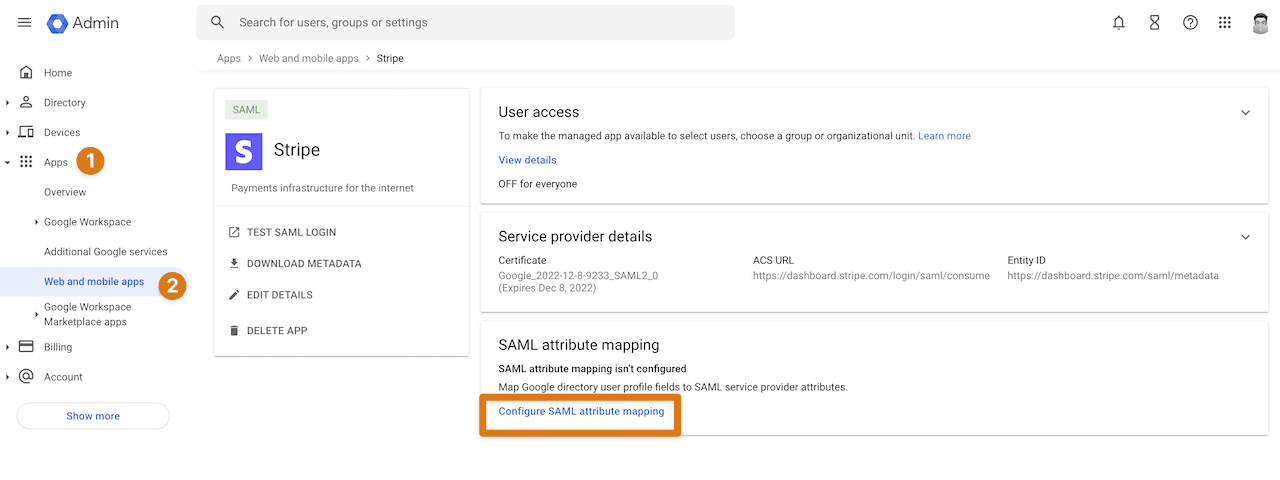
- Add a row for each Stripe account you want to authenticate your team to, and click Save.
- Google Directory attributes is the custom field you configured.
- App attribute is the Stripe account to connect to. The format is
Stripe-Role-. The account ID value is your currently logged in account, such as: .
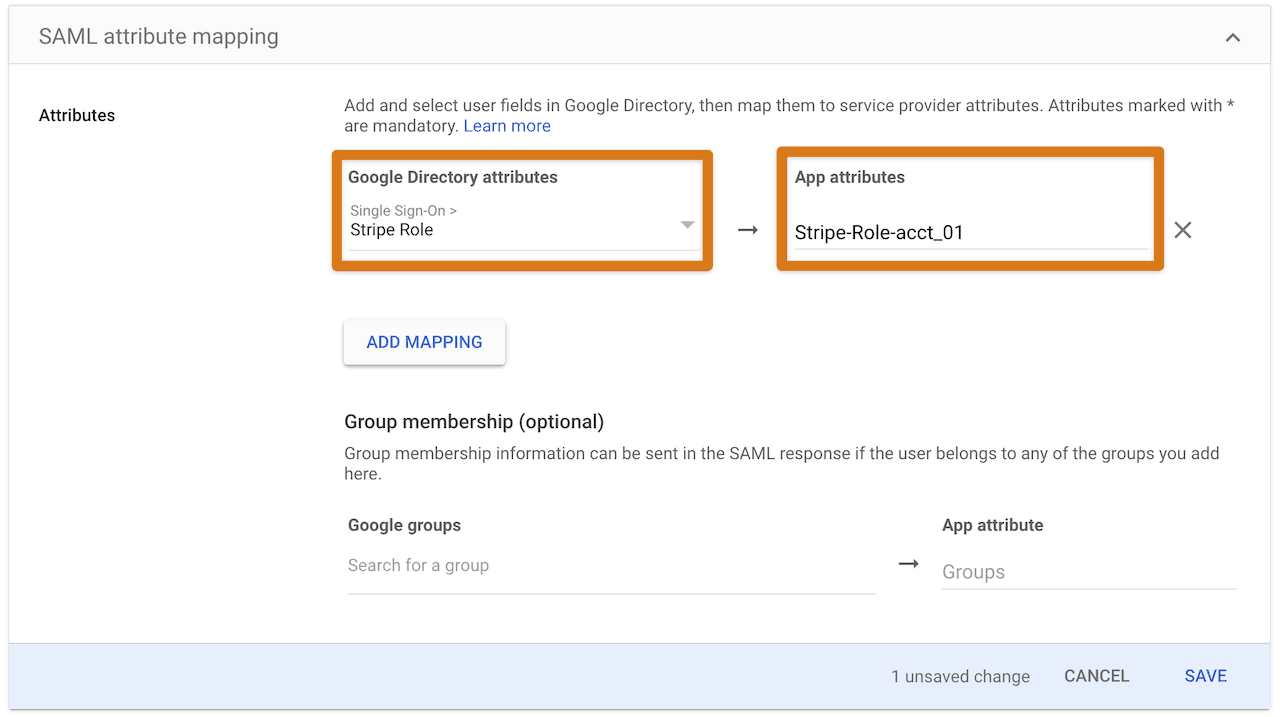
Multiple Stripe accounts support
Add one Attribute Mapping per account.

You can find the list of account tokens in the Accounts section of your Personal details settings.
Assign roles to your team
- After you set up your SAML application, enable it for your users. Click Edit service at the top right of the application details.
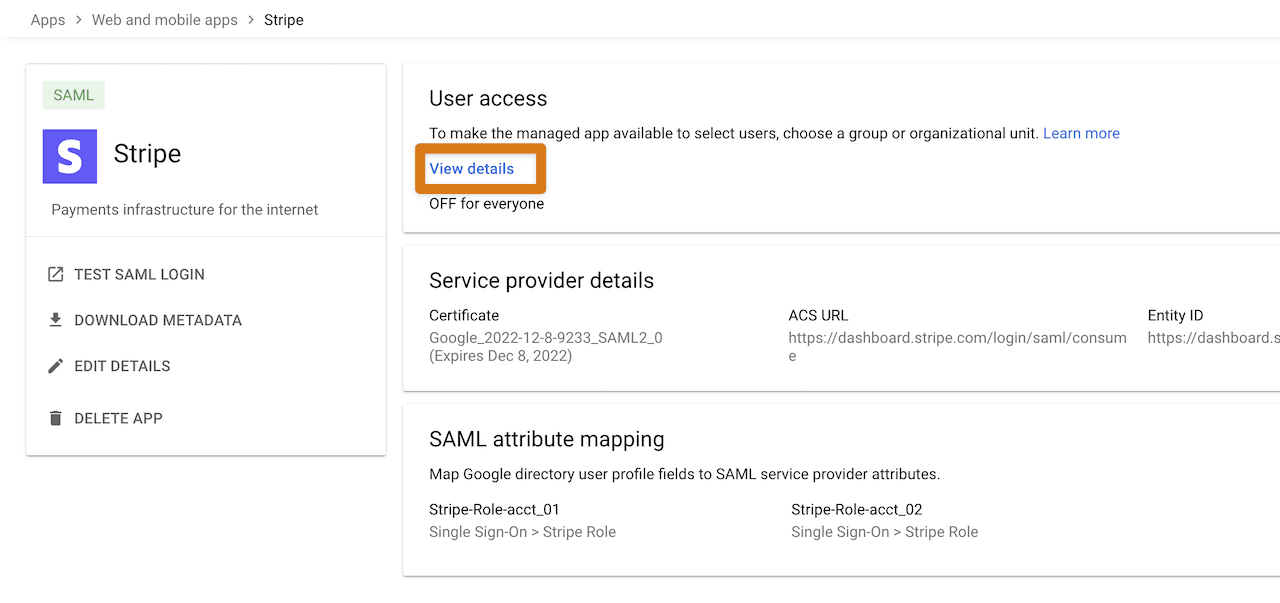
- Select
ON for everyone, and click Save.
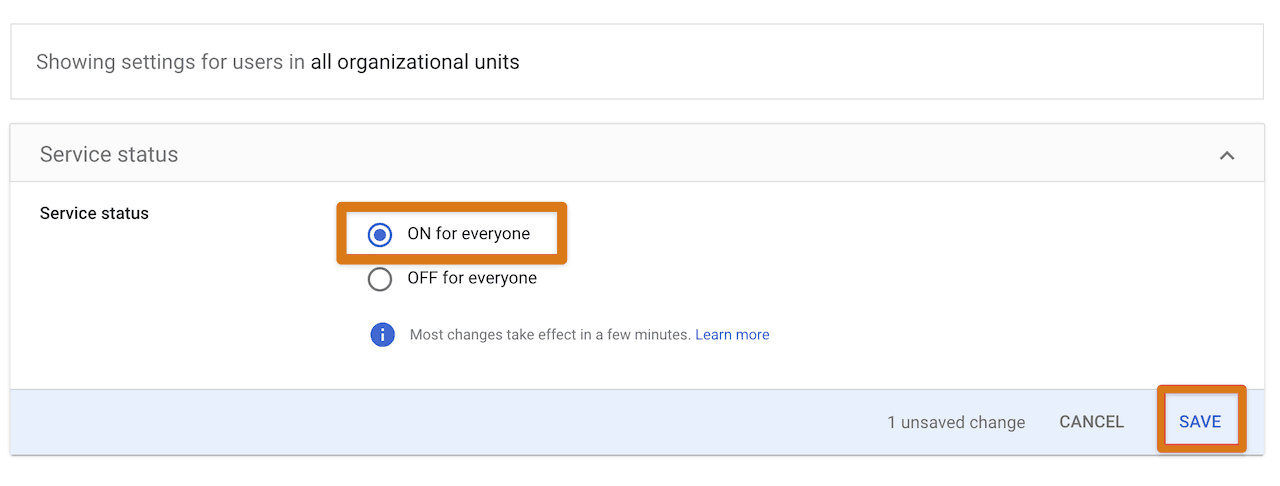
- For each team member, set a Stripe role on their User Information page in the Directory. Navigate there in the main menu by clicking Directory, then Users. Select the user you want to set a role for from the list, click User Information, and scroll down to your new attribute.

- To assign multiple roles to a user upon login, you can add a semicolon after each role. For example, you can set the attribute as
analyst; developer. In this case, the user obtains theanalystand thedeveloperrole when they sign in.
Stripe supports distinct Dashboard roles for each Stripe account. This allows team members to have the appropriate permission for each account they have access to.
Stripe supports the following roles. Some of these roles are only available if your account uses the applicable Stripe product. For more information, see User roles supported by Stripe.
| Role | Value |
|---|---|
| Administrator | admin |
| Analyst | analyst |
| Cardholder | cardholder |
| Connect Onboarding Analyst | connect_ |
| Connect Risk Analyst | connect_ |
| Data Migration Specialist | data_ |
| Developer | developer |
| Dispute Analyst | dispute_ |
| Financial Connections Specialist | financial_ |
| IAM Admin | iam_ |
| Identity Analyst | identity_ |
| Identity View only | identity_ |
| Issuing Support Agent | issuing_ |
| Opal View only | opal_ |
| Sandbox Administrator | sandbox_ |
| Sandbox User | sandbox_ |
| Super Administrator | super_ |
| Support Associate | support_ |
| Support Communications | support_ |
| Support only | support_ |
| Support Specialist | support_ |
| Refund Analyst | refund_ |
| Tax Analyst | tax_ |
| Terminal Specialist | terminal_ |
| Topups only | topups_ |
| Top-up Specialist | topup_ |
| Transfer Analyst | transfer_ |
| View only | view_ |
Configuring Stripe
Enter values from your identity provider
Configure your Stripe account to connect to your identity provider from the User authentication page.
To configure Stripe to connect to your identity provider you’ll need:
- Issuer ID: An identifier of your identity provider.
- Identity provider URL: The URL of your identity provider that your team members are redirected to, so they can authenticate.
- Identity provider certificate: The X.509 certificate that your identity provider uses to signs assertions.
Find these values in your identity provider
If you don’t have these values from Step 1, go to the SAML application you created earlier, select Service Provider Details, and click Manage certificates.
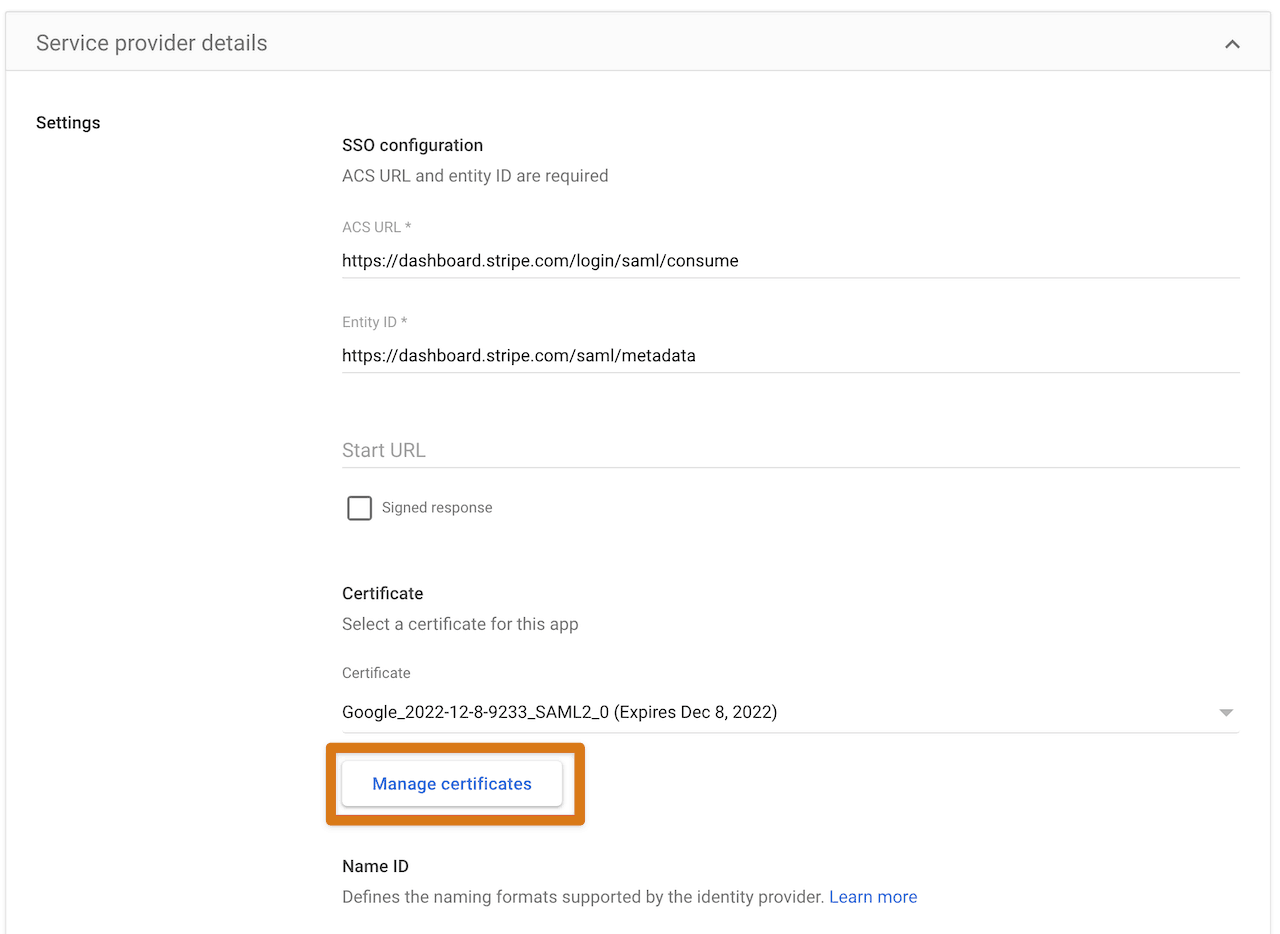
This opens a new window with the following information:
| Name of property in Stripe | Name of property in Google Workspace |
|---|---|
| Identity provider URL | SSO URL |
| Issuer ID | Entity ID |
| Identity provider certificate | Certificate 1 |
Download a copy of Certificate 1 to allow you to copy the certificate to Stripe.
Test your configuration
Before saving your settings, a test runs to validate your SSO integration. After you click the Test button, a window opens in your browser that redirects to your identity provider to sign in. After you sign in, the window automatically closes and test results display on the original page.
If the test succeeds, you can save the settings, and select an enforcement mode. If the test fails, modify your configuration to address the issues reported and test the integration again.
Select an enforcement mode for SSO
When using SSO, there are three separate enforcement modes that you can choose from. These affect which methods of authentication your team members can use.
| Mode | SSO authentication allowed | Regular authentication allowed |
|---|---|---|
| Off | No | Yes |
| Optional | Yes | Yes |
| Required | Yes | No |
Authenticate with SSO
After you finish configuring SSO, you can inform your users to sign in with any of these methods:
Stripe’s sign in page
Users can go to the Stripe sign in page, enter their email, then select Use single sign-on (SSO).
If a user has access to multiple accounts, Stripe authenticates them with the default account connected to the user. If a user only has access to SAML merchants, or doesn’t have access to any merchants, Stripe redirects them to the IdP, regardless of the contents in the password field.
IdP-initiated login
To use IdP-initiated login, your IdP needs to support Service Provider-initiated login. Verify if this is possible using your IdP’s documentation.
SSO URL
Use the following login URL with your domain to directly sign in to your account with SSO. This URL includes the domain and account you want to use for SSO authentication. If you change the account token at the end of the URL, it authenticates you against a different account.
https://dashboard.stripe.com/login/saml_direct/domain/{{YOUR_DOMAIN}}/merchant/{{STRIPE_ACCOUNT_ID}}
Support for multiple Stripe accounts
If you’re configuring SSO for multiple Stripe accounts, first create an organization to centrally configure SSO across all of your accounts. You can change the account token at the end of the SSO URL to authenticate against another account. You can find the list of account tokens in the Accounts section of your Personal details settings.
Multiple IdP connections: If you have multiple Stripe businesses with multiple IdP settings (for example, different SAML endpoints or issuer IDs) but share the same domain, we recommend using login URLs.
Revoke team member access
You can revoke a team member’s access using either active or passive methods.
Actively revoke access with an assertion
Send Stripe an assertion from your identity provider to grant a team member access to specific Stripe accounts. This also lets you revoke a team member’s access. To revoke access for a team member, assign them a role of none for the Stripe account’s access you want to revoke. For example:
<saml2:attribute name="Stripe-Role-STRIPE-ACCOUNT-ID" NameFormat="urn:oasis:names:tc:SAML:2.0:attrname-format:basic"> <saml2:attributevalue>none </saml2:attributevalue> </saml2:attribute>
Cuidado
You can’t revoke access for the owner of a Stripe account.
Passively revoke access with enforcement mode
When enforcement mode is set to required, only team members who can authenticate with your identity provider can access your Stripe account. In required mode, you can revoke a team member’s access to a Stripe account by preventing your identity provider from authenticating them. In the Stripe Dashboard, set SSO to required in User authentication.
Rotate Identity Provider Certificate
Follow these steps to rotate the primary signing certificate for your SSO domain in Entra ID. This process ensures that you can test the new certificate before you make it the primary.
Generate a new certificate
Create a new certificate to replace your existing primary certificate:
- Open your Stripe application in Google workspace.
- Go to Service provider details.
- Click Manage certificates and Select Add certificate.
- Download the new certificate.
Add the new certificate in Stripe
Add the new certificate as a secondary certificate in Stripe:
- In the Stripe Dashboard, go to Settings > Team and security > Single sign-on (SSO).
- Select the domain from the list for which you want to rotate the certificate.
- Click Add in the certificate section.
- Copy and paste the downloaded certificate.
- Click on Continue to add the new certificate.
Activate the new certificate
Make the new certificate active in your IdP:
- Open your Stripe application in Google Workspace.
- Go to Service provider details.
- In the certificate section, select the dropdown and choose the new certificate.
- Click Save.
- Verify that the new certificate is displayed as the selected one in the dropdown.
Test the new certificate
Ensure that users can log in by using SSO with the new certificate:
- Log out from both Stripe and Google workspace.
- Use SSO to sign in again and check for errors.
Set the new certificate as primary
Make the new certificate primary in Stripe:
- In the Stripe Dashboard, go to Settings > Team and security > Single sign-on (SSO).
- Select the domain from the list for which you want to rotate the certificate.
- Click the overflow menu of the secondary certificate and select Set as primary.
- Verify that the new certificate is displaying the primary label.
After completing these steps, you can optionally delete the old certificate by clicking the overflow menu and selecting Delete.